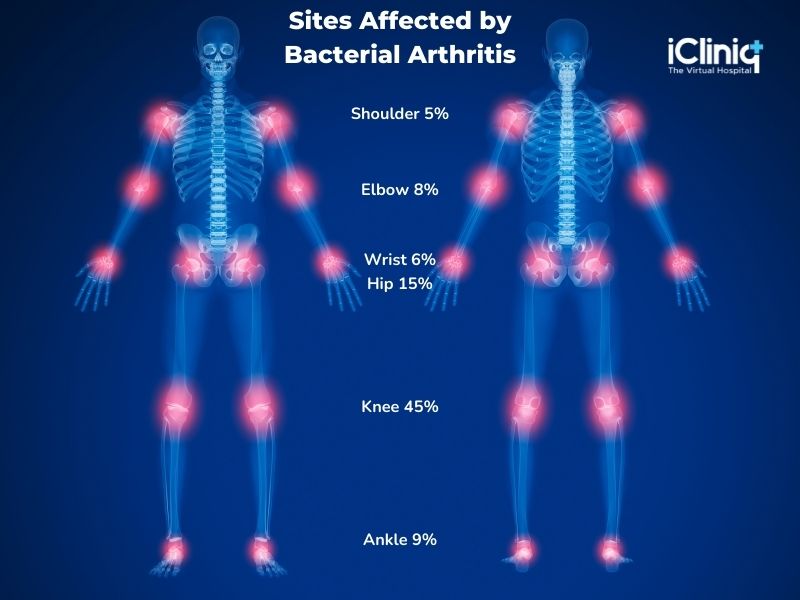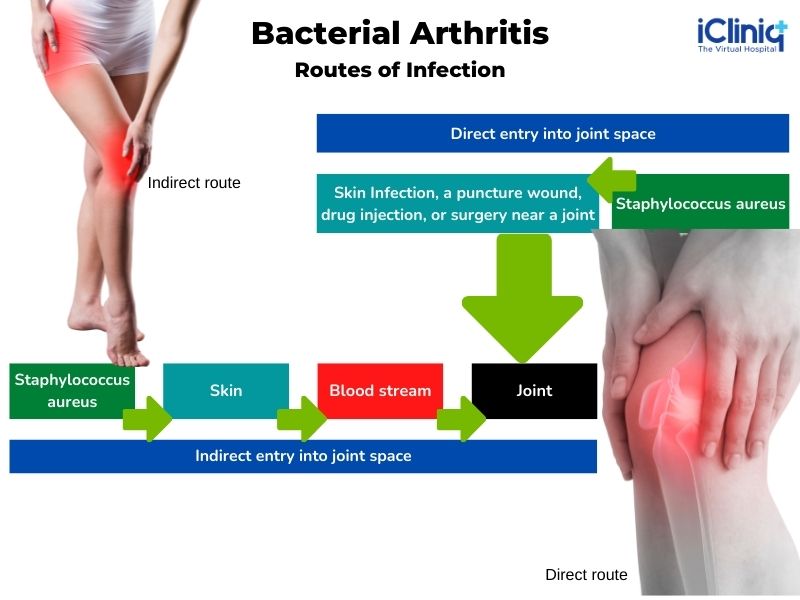What Is Bacterial Arthritis?
Bacteria can enter your joint and cause rapid cartilage and bone degradation leading to inflammation of a joint. It is also known as septic arthritis or bacterial arthritis.

Joint inflammation caused by an infectious agent—typically a bacterial one, but occasionally a fungus, mycobacterium, virus, or other unusual pathogens—is known as septic arthritis. Septic arthritis often affects a single big joint, such as the hip or the knee, but it can also affect numerous smaller joints or be polyarticular. Septic arthritis is an orthopedic emergency that, despite its rarity, can seriously harm joints, increasing morbidity and mortality. In order to maintain joint function, early diagnosis and therapy are essential. An increase in concomitant predisposing diseases has been linked to an increase in long-term death rates in elderly individuals with septic arthritis.
The prevalence of septic arthritis varies depending on the presence of risk factors and ranges from two to six cases per 1,00,000 people. Compared to adults, kids are more likely to develop septic arthritis. The prevalence of septic arthritis is highest in children between the ages of two and three and is more common in men (2:1). High-risk subgroups of children include newborns, hemophiliacs with hemarthrosis, immunocompromised (such as sickle cell anemia, HIV infection), and chemotherapy patients. Age over 80, diabetes, arthritis, recent joint surgical intervention, joint replacements, prior intra-articular injection, skin problems and dermal ulcers, human immunodeficiency virus, osteoarthritis, sexual relations (especially in cases of suspicious gonococcal septic arthritis), and other causes of sepsis are risk factors in adults.
What Are the Types of Bacterial Arthritis?
-
Gonococcal arthritis (GA).
-
Non-gonococcal arthritis (NGA).
What Is Non-gonococcal Arthritis?
-
Non-gonococcal arthritis is the most harmful type of arthritis.
-
Increased duration of untreated joint infection can lead to increased joint destruction.
-
Early detection and treatment are essential.
-
The most commonly affected joints are the shoulder, elbow, hip, wrist, knee, and ankle.
-
Other joints can also be affected - Polyarticular septic arthritis.
-
A single red, hot, and swollen joint is typical of non-gonococcal septic arthritis in the sites illustrated below:

Polyarticular Septic Arthritis:
Bacteremia is common in patients with polyarticular septic arthritis, and they have a higher mortality rate. The following joints are affected in intravenous drug users:
-
Sternoclavicular joints.
-
Acromioclavicular joints.
-
Sacroiliac joints.
What Is Gram-Negative Septic Arthritis?
-
Caused by pseudomonas and other gram-negative bacteria.
-
Most commonly occurs in elderly and immunocompromised patients.
What Is Gonococcal Septic Arthritis?
It usually occurs as a part of disseminated gonococcal infection syndrome. Disseminated gonococcal infection syndrome causes urethritis (inflammation of the urethra), tenosynovitis (inflammation of the sheath covering the muscle attached to bone), septic arthritis, hemorrhagic rash, and pustular rash.

What Bacterial Skin Disease Causes Arthritis?
Staphylococcus aureus, which can be present even in normal skin, causes bacterial arthritis. It reaches the joint space to cause inflammation through the following routes:

The bacteria enter the joint space both directly and indirectly. Any puncture wound, drug injection, or surgery near a joint can get infected by the bacteria, and this is how the bacteria directly enters the joint space. Bacteria can also reach the joint in other ways also. Bacteria on the skin surface can reach the bloodstream through skin pores, skin abrasion, etc. Bacteria from the bloodstream enter various joint spaces and cause an infection.
What Are the Symptoms of Bacterial Arthritis?
Fever, pain, inflammation of the joints, fatigue, lack of appetite, and increased blood pressure are the symptoms of bacterial arthritis.
Signs and symptoms, such as slight discomfort and swelling, may appear months or years after having a knee or hip replacement surgery if septic arthritis (prosthetic joint infection) affects an artificial joint. Additionally, joint loosening may take place, which hurts while moving the joint or putting weight on it. Rest usually makes the ache go away. The joint may also get dislocated under severe situations.
What Is Acute Bacterial Arthritis?
Bacterial infections in other parts of the body can also cause inflammation of joints.
The different types of bacteria and their infections are as follows:

Staphylococcus aureus causes staph infections in the body. Strep throat is the most common infection caused by Streptococcus species. Bacterial pneumonia is commonly infected by Streptococcus pneumonia. Neisseria gonorrhoeae, Mycobacterium tuberculosis, and Borrelia burgdorferi are the sources of Gonorrhea, tuberculosis, and Lyme diseases. All these infections can infect all the joint spaces in common.
How to Diagnose Bacterial Arthritis?
History and physical examination help to identify the source of infection. As the signs and symptoms are common, there are no specific symptoms for the confirmation of the disease. Lab investigations can be done to confirm the diagnosis. Culture of blood and synovial fluid can be done. Other tests like gram stain, blood tests like common blood count (CBC), erythrocyte sedimentation rate (ESR), and C-reactive protein (CRP) can also be done. But still, all these investigations are not confirmative. Imaging studies like X-rays and magnetic resonance imaging (MRI) can also help in the diagnosis of bacterial arthritis. Based on the signs and symptoms, the investigations are carried out. Yes, a biopsy is the confirmative diagnosis of bacterial arthritis.
How to Treat Bacterial Arthritis?
-
Intravenous antibiotics.
-
Oral antibiotics for two to six weeks based on the type of bacterial infection.
-
Arthrocentesis (draining joint fluid using arthroscopy).
-
Physiotherapy (to reduce joint stiffness).
-
Anti-inflammatory medications (to reduce joint inflammation and swelling).
Septic arthritis can cause joint deterioration and irreparable harm if treatment is postponed. Joint loosening or dislocation are potential problems if septic arthritis affects an artificial joint.
What Are the Prognosis of Bacterial Arthritis?
In-hospital septic arthritis has a mortality rate of 7 % to 15 % despite the use of antibiotics. One-third of individuals with septic arthritis experience morbidity. With a patient's age, concomitant diseases such as already existing joint disease, and prior synthetic intra-articular material, both morbidity, and mortality rise. This emphasizes the importance of having a high index of suspicion for septic arthritis, early diagnosis, and fast treatment, especially in patients with established predisposing risk factors and concomitant diseases. Neisseria infections seldom result in death, whereas infections brought on by Staphylococcus can have a fatality rate of more than 50 %.
Conclusion:
Septic arthritis is a rare orthopedic emergency that needs to be diagnosed in a patient with risk factors with a high level of suspicion. Even with appropriate care, aged patients, those with a history of arthritis, and those with intra-articular prostheses have high morbidity and mortality rates. The primary symptom of septic arthritis is typically an acute, monoarticular joint inflammation with a wide range of possible diagnoses. An interprofessional team manages the infection best due to the significant morbidity and mortality.













